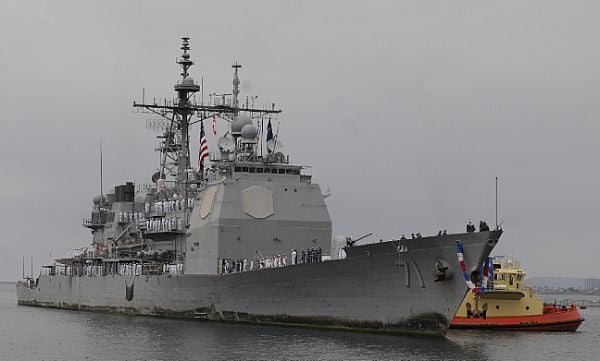
“Money is better spent on buying back the life of younger ships” with 25 to 30 years left, than putting it into seven cruisers the Navy wants to retire in 2015, the deputy chief of naval operations for warfare systems told a key House subcommittee on 26 April.
Vice Adm. William Burke said, “We have to balance our books” and the way the Navy chose to do that a year ago was retiring the cruisers and two landing ship docks (LSDs) early. “I would prefer to put money into destroyers,” he said, adding that “we have enough” cruisers, all nine of which the Navy intends to operate normally until they are decommissioned.
The Navy has a maintenance backlog on destroyers that would be addressed under this plan, he said.
If there were more money available to buy back ships, Burke said he would spend it on the LSDs. “We don’t meet that requirement” of having 33 amphibious lift ships. “We are struggling to get to 33.” Marine Lt. Gen. Richard Tryon, deputy commandant for plans, policies and operations, told the House Armed Services Readiness Committee that there are 31 now, but that number will drop to 28.
Burke said that Navy only received the money to modernize the cruisers last month when an appropriations bill replaced the Continuing Resolution that severely limited where money could be spent. The time limit for spending that money was set at two years. “If that were extended, it would give us some flexibility” in deciding what ships are to be retired.
Vice Adm. Philip Cullom, deputy chief of naval operations for fleet readiness and logistics, added, “You couldn’t do all those cruisers in two years,” some having superstructure damage.
Rep. Rob Wittman (R-VA), the panel chair, said the Navy’s credibility “continues to be eroded” on Capitol Hill when it retires ships early—such as the cruisers—and then asks to build a new class of ship. “We’ve got to get back to life-cycle costs” in figuring how much a ship actually costs from construction through decommissioning.
If sequestration continues through Fiscal Year 2014, Cullom said, “we don’t have that surge capability” beyond the carrier strike groups and amphibious readiness group deployed, or next to deploy. It would take more time than called for in warfighting plans to bring ships, aircraft and crews to acceptable levels of readiness, he added.
It “could easily get up to 80 percent [from about 60 percent now] not ready to deploy.” Cullom said that cannibalization of equipment is stable now, “but cross-decking has actually increased [in] people and spare parts.
Similarly, the Marine Corps “could be at a severely unacceptable level [of readiness] in 2014, ” Tryon said, if sequestration continues. The Marine Corps said 50 percent of its force is not ready for immediate deployment.
An immediate impact of sequestration is civilian furloughs expected to begin this spring, although the Defense Department has not set the number of days that workers—many at depots and shipyards—will stay home without pay. Lt. Gen. William Faulkner, deputy commandant for installations and logistics, said there is “no intention” of moving Marines to fill those vacancies when they occur. “It’s a risk we’re going to have to take.”
Cullom said the impact of the furloughs will be far greater than the number of days lost to unpaid leave because “we rely on overtime” to meet demand. “The impact can be as high as 40 percent” rather than the 20 percent of the time expected to be set aside for furloughs.
Burke said that sequestration has driven the Navy to “put more ships forward . . . to get more bang for the buck” and the service is also “looking hard at our administrative overhead to see what we can skim.”
Faulkner said 60 percent of the equipment that was in Afghanistan has been returned, is being worked on in Marine Corps depots and is on track to be returned to units. “We definitely have a sense of urgency to do this as quickly as possible.”





